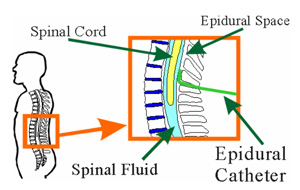
There are different types of anesthetics that may be used for your surgery. The decision as to which type of anesthesia that will be used will be dependent upon your personal medical history, the type of surgery you are scheduled for, your surgeon’s preference and your anesthesiologist. With all types of anesthesia, you will be monitored very closely. The anesthesiologist will monitor your breathing and blood oxygen level, heart rate, blood pressure, EKG and temperature. In our practice, an Anesthesiologist will always be present.
These different kinds of Anesthesia include the following:
- General Anesthesia
- Regional Anesthesia – Including Epidural, Spinal and Nerve Block Anesthesia
- Combined General and Epidural Anesthesia
- Monitored Anesthesia Care with Conscious Sedation
The risks and benefits of the various types of anesthetic will be discussed with you by your anesthesiologist prior to your surgery. Please take the time to ask any questions that you might have. Remember, the decision as to the type of anesthesia to be administered is ultimately up to your anesthesiologist. We strive to provide you with the safest anesthetic and best surgical outcome possible.
During general anesthesia, medications are given so patients are unconscious (“asleep”) and unable to feel any pain during the surgical procedure. Some of these medications are given through an IV and others are gases mixed with oxygen and administered through a breathing mask or tube. Some of the side effects of general anesthesia include nausea, vomiting, sore throat, muscle aches, shivering and confusion. General anesthesia is the most common type of anesthetic administered.
Regional anesthesiology entails injecting a local anesthetic (numbing medicine) near nerves to numb a portion of the body. There are several types of regional anesthetics including spinal anesthesia, epidural anesthesia and various specific nerve blocks. Regional anesthesia can be used by itself, or combined with sedation or general anesthesia, depending on the surgery and patient’s needs.
 Epidural anesthesia involves the injection of a local anesthetic, usually with a narcotic, into the epidural space. The epidural space is outside of the spinal cord. Epidural anesthesia is most often administered via a pump through a small catheter (tube), which allows for a long duration of pain control (the anesthetic does not wear off until the pump is turned off and the catheter removed). This type of anesthesia is commonly used in labor and delivery and for procedures of the lower extremities. Occasionally, we place epidurals for post-operative pain control for extensive abdominal surgeries.
Epidural anesthesia involves the injection of a local anesthetic, usually with a narcotic, into the epidural space. The epidural space is outside of the spinal cord. Epidural anesthesia is most often administered via a pump through a small catheter (tube), which allows for a long duration of pain control (the anesthetic does not wear off until the pump is turned off and the catheter removed). This type of anesthesia is commonly used in labor and delivery and for procedures of the lower extremities. Occasionally, we place epidurals for post-operative pain control for extensive abdominal surgeries.
 Spinal anesthesia also involves the injection of a local anesthetic, with or without a narcotic, into the fluid that surrounds the spinal cord. This type of anesthesia is commonly used for Cesarean sections, pelvic surgeries, hip and knee replacements, and other procedures of the lower extremities.
Spinal anesthesia also involves the injection of a local anesthetic, with or without a narcotic, into the fluid that surrounds the spinal cord. This type of anesthesia is commonly used for Cesarean sections, pelvic surgeries, hip and knee replacements, and other procedures of the lower extremities.
Nerve blocks are used to block pain at a specific site. By injecting a local anesthetic into or around a specific nerve or group of nerves, pain relief can be localized to the site of surgery. This type of anesthesia provides pain control during and after a procedure, It is associated with minimal side effects. Examples of nerve blocks include an adductor canal nerve block for knee surgery, an interscalene nerve block for shoulder surgery, and a supraclavicular nerve block for arm and hand surgery.
This is a combination technique where general anesthesia is used to provide unconsciousness during surgery, and epidural anesthesia is used to provide pain control both during and after the procedure. The placement of the epidural catheter allows for you to have continued pain relief after surgery, which will help you sleep, breathe, and to move more comfortably after surgery. This type of anesthesia is commonly used for major abdominal and thoracic (chest) procedures. The epidural catheter may be left in place for several days after your surgery, during which time an anesthesiologist will help with pain management.
Monitored Anesthsia Care (MAC) involves the injection of medications through an IV to help you relax, as well as to block pain. MAC is a state of consciousness somewhere between being totally awake and totally asleep (general anesthesia). During MAC, a combination of sedative and narcotic medications are used to help you tolerate a procedure that otherwise would be uncomfortable. In addition, the surgeon may inject a local anesthetic at the site of the procedure for pain control. With this type of anesthesia, you are able to respond to questions, but will be drowsy throughout the procedure and may not remember anything. An anesthesia provider will be present constantly to monitor your breathing and vital signs and assist you as necessary. Please keep in mind that if for any reason you are unable to tolerate this type of anesthetic, there may be a need for a general anesthetic to be administered to complete the procedure safely.